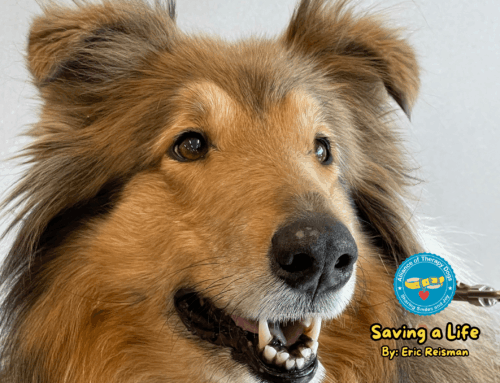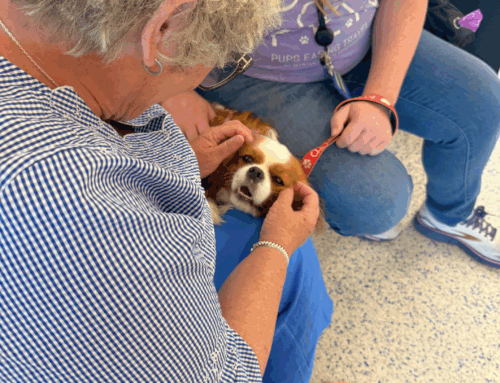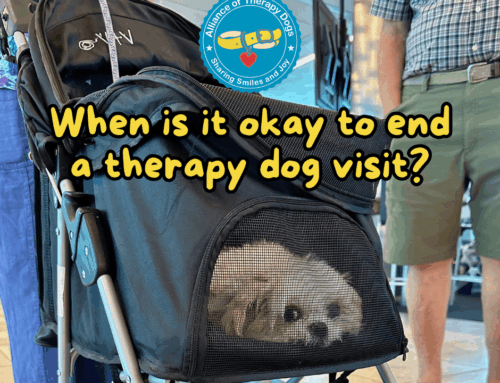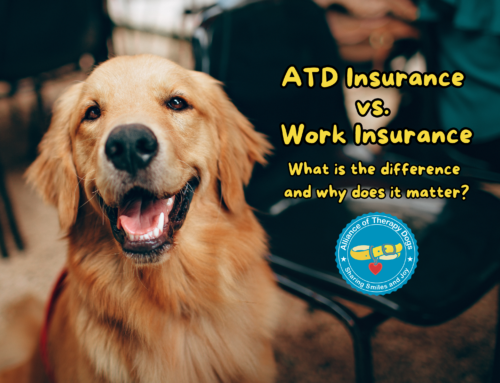This educational series offered by ATD and taught by ATD board member Laurie Schlossnagle, KPA CTP, CCUI, PCT-A, CBCC-KA, CPDT-KA, TAG teacher Level 1 is intended to support handlers and their dogs as they prepare to resume in-person visits after a prolonged suspension due to the COVID-19 pandemic. COVID-19 has changed the way therapy dogs share smiles and joy with the public, with many handlers choosing to do window visits, online visits, or sharing life-size cutouts of their dogs with the facilities they would normally visit in person. If you prefer to watch these sessions, you can find them on our YouTube channel.
Is Noticing Stress Important?
The most important thing about understanding dog body language is to know your dog. While ATD expects its Tester/Observers to have a stronger ability to evaluate stress signals in various breeds of dogs, most handlers knowing your dog is the most important part of being a good therapy dog handler. Even the best, most social, most outgoing, and happiest of therapy dogs get stressed in certain situations, and it’s up to that dog’s handler to notice those stress signals and relieve the dog from the situation.
We always want our dogs to be happy. A handler must understand his or her dog’s stress signals because stressed therapy dogs can behave unpredictably. Not only is stress an unnecessary discomfort for the dog to experience, but it increases the risk of an accident because the dog is uncomfortable. If a dog is stressed because she feels unsafe, she may be more likely to nip or jump, which is never appropriate on a visit. Just as importantly, dogs should enjoy visiting as much as handlers, and stress means no fun.
What are Common Stress Signals?
Every dog displays its stress a little differently. Some typical stress signals, such as a tucked tail, maybe not be stress signals for certain breeds like whippets and greyhounds. This is why it’s important to know your dog: when she’s happy, when she’s tired, when she’s stressed or anxious and ready to call it quits.
Here are some common, yet subtle, signs of stress your dog might show you on a visit that means it’s time to leave that situation:
- Panting – is it hot, or is your dog uncomfortable in the scenario?
- Shivering – some small dogs tremble frequently, but for many, this is a stress signal.
- Scratching/Licking himself
- Spatulate tongue – is your dog’s tongue straight and firm rather than loose and floppy? If so, this could be a stress signal.
- Yawning – yawning when it’s time for bed or when waking in the morning are normal behaviors. Yawning on a visit, especially quick yawns or yawns with vocalization, are good indicators of an uneasy pup.
- Belly up – this signal requires your attention to detail. If your dog has a relaxed, loose, wiggly body, then a belly-up is most likely a request for tummy rubs. If your dog shows her belly but has a tense, straight body and maybe some other stress signals in this list, your dog is telling you she’s stressed, worried, or afraid.
- Shaking off – a full body shake, like your dog does after a bath, is a calming signal to other dogs. Your dog may use a full body shake to diffuse a tense situation or tell other dogs she’s ready for play to de-escalate. Shaking during a therapy visit is a signal your dog tries to ease herself or others around her.
- Blowing of coat – excessive acute shedding often means nerves and discomfort – that’s why you see so much hair at the veterinarian’s office!
- Dilated pupils/whale eye – wide-open eyes so you can see the whites around the eye and pupils larger than normal are stress signs. Some breeds naturally have a whale eye; know your dog and his eyes at home when he’s relaxed to compare them to an anxious scenario.
- Tongue Flick/Lip Licking – quickly licking lips or flicking the tongue in and out can signal your dog is stressed. Be mindful if you’re giving treats because sometimes tongue flicks and lip licks can be for tasty snacks and not due to stress.
- “Smiling” – smiling is when your dog pulls the back of her mouth back and up towards her eyes. This makes dogs look like they’re smiling at us, but your dog is really telling you she’s a little uncomfortable. Again, some breeds naturally smile, like pitbull-type dogs and golden retrievers – be aware of what this means in your dog!
- Sniffing the ground – sniffing is an avoidance of what’s going on around your dog. This tells you he wants to disengage from the current circumstance and is a little uncomfortable. Don’t let your therapy dog sniff the ground on a visit – you never know what he can pick up quickly that you can’t see!
- Leaning/turning away – leaning away from you or people you’re visiting is another avoidance technique from dogs who are uncomfortable and want to tell their handlers they’d rather be in a different scenario.
- Hypervigilance/pacing – we don’t see pacing on therapy visits because your dog is on a leash with you, but you may notice hypervigilance. Hypervigilance may be looking behind you while walking down the hallway, ears constantly perked and not paying attention to you, constant scanning with the head or the eyes.
Here are some more obvious stress signals your dog may show you:
- Vocalizing – whining or crying are clear indicators your dog is distressed.
- Urinating – don’t be fooled by a dog who urinates when he’s ‘happy’ or ‘excited.’ This dog is still stressed by the situation and needs help de-escalating the situation to feel more comfortable.
- Excessive licking – if your dog is excessively licking you, people you’re visiting, or himself, he may be uncomfortable. We don’t want therapy dogs licking on visits anyway – there are too many chemicals on the skin, and many people don’t like smooches.
- Hiding – a dog who hides behind her handler or another barrier is stressed. Pursuing a dog trying to hide could result in a nip or a growl.
- Avoiding – a dog who ducks his head away from pets averts his eyes, moves to the other side of your body when you try to present him for petting is a stressed dog and is not enjoying the visit.
- Cowering – a dog who crouches low on the ground is trying to avoid being in the situation and is stressed out.
- Tail tucked/tail carriage – know your breeds and know your dogs. For some dogs, the tail carriage is an obvious indicator of mental well-being. For others, it’s just the confirmation of the dog and doesn’t convey an attitude or mental state.
- Flattened Ears – ears pinned to the head are a good indicator your dog is stressed. Again, some breeds have naturally pinned ears, so know your dog.
What you and tester/observers look for in a dog on a visit:
Now you know what subtle and obvious stress signals are in dogs, here are some signals that tell us the dog is enjoying herself, having a good time, and relaxed.
- Bouncy gait
- Relaxed face and body
- No tension in movement
- Wiggly behind
- Smooth, wide tail wags
- Curved body, leaning in
- A comfortable, relaxed tail, appropriate for the breed/breed mix.
Determining whether your dog is happy, relaxed, and enjoying himself or whether he is stressed, anxious, and ready to leave the situation requires you to look at your whole dog. Dogs often have “tells” to indicate to their handlers when they’re ready for the visit to be over – pulling toward the door, sitting or lying down and refusing to get up, pawing at the handler. Listen to your dog – she’s not trying to be cute, she’s trying to communicate, and she needs you, as her advocate, to make sure she feels happy, safe, and secure on her visit. Thank you for being part of the ATD family!






